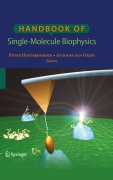
During the last decade, a number of novel biophysical methods have been developed that allow the manipulation and study of individual biomolecules. The ability to monitor biological processes at the fundamental level of sensitivity, that of a single molecule, has given rise to an improved understanding of the underlying molecular mechanisms. Through the removal of ensemble averaging, distributions and fluctuations of molecular properties can be characterized, transient intermediates identified, and catalytic mechanisms elucidated. By applying forces on biomolecules while monitoring their activity, important information can be obtained on how proteins couple function to structure. The Handbookof Single-Molecule Biophysics provides an introduction to these techniques and presents an extensive discussion of the new biological insights obtained from them. Editorial Advisory Board: Daniel Müller, Cheng Zhu, Claus Seidel, Xiaowei Zhuang, Thomas Schmidt, Nynke Dekker. Describes experimental techniques tomonitor and manipulate individual biomolecules, including fluorescence detection, atomic force microscopy, and optical and magnetic trapping Includes single-molecule studies of physical properties of biomolecules such as folding, polymer physics of protein and DNA, enzymology and biochemistry, single moleculesin the membrane, and single-molecule techniques in living cells INDICE: 1 - Single-molecule fluorescence tracking. 2 - Single molecule studies in the membrane. 3 - Single-molecule imaging in live cells. 4 - Superresolution imaging. 5 - Fluorescence Resonance Energy Transfer. 6 - Single-molecule enzymology. 7 - Rotary proteins. 8 - Fluorescence Correlation Spectroscopy. 9 - Advanced Concepts of Fluorescence Fluctuation Spectroscopy. 10 - Nucleic-acid analysis at the single-molecule level. 11 - Nanopores: Geneneration and Single-Molecule Applications. 12 - Optical trapping. 13 - Magnetic tweezing. 14 - Protein/DNA unfolding. 15 - Single molecule. 16 - Nano-scale AFM imaging. 17- High Speed AFM. 18 - Recognition imaging. 19 - Atomic force microscopy of protein-protein interactions. 20 - A New Approach to Analysis of Single Molecule Force Measurements. 21 - Single Molecule Recognition: Extracting Informationfrom Individual Binding Events and Their Correlation.
- ISBN: 978-0-387-76496-2
- Editorial: Springer
- Encuadernacion: Cartoné
- Páginas: 1016
- Fecha Publicación: 01/06/2009
- Nº Volúmenes: 1
- Idioma: Inglés
